Value Based Leadership: Exploring Military Strategies and Impacts
VerifiedAdded on 2020/02/24
|8
|1988
|96
Essay
AI Summary
This essay examines value-based leadership within the military, defining it as a strategy emphasizing organizational values like integrity, perseverance, and discipline. It highlights the importance of aligning leaders' personal values with those of the organization, reflecting in its vision, mission, and principles. The essay contrasts military leadership with business leadership, emphasizing the military's focus on saving lives. It explores key values such as integrity, determination, and collaboration, illustrating how leaders like Lieutenant General Janet Wolfenbarger exemplify these traits. The essay discusses the advantages of value-based leadership, including expanded leadership thinking, improved communication, and the ability to address complex challenges in a changing world. It emphasizes the importance of fostering a strong organizational culture, encouraging feedback, and developing a sense of community within the military. The essay concludes by highlighting how value-based leadership influences decision-making, inspires subordinates, and contributes to the overall success and sustainability of military missions. The document is contributed by a student and available on Desklib, a platform providing AI-based study tools.
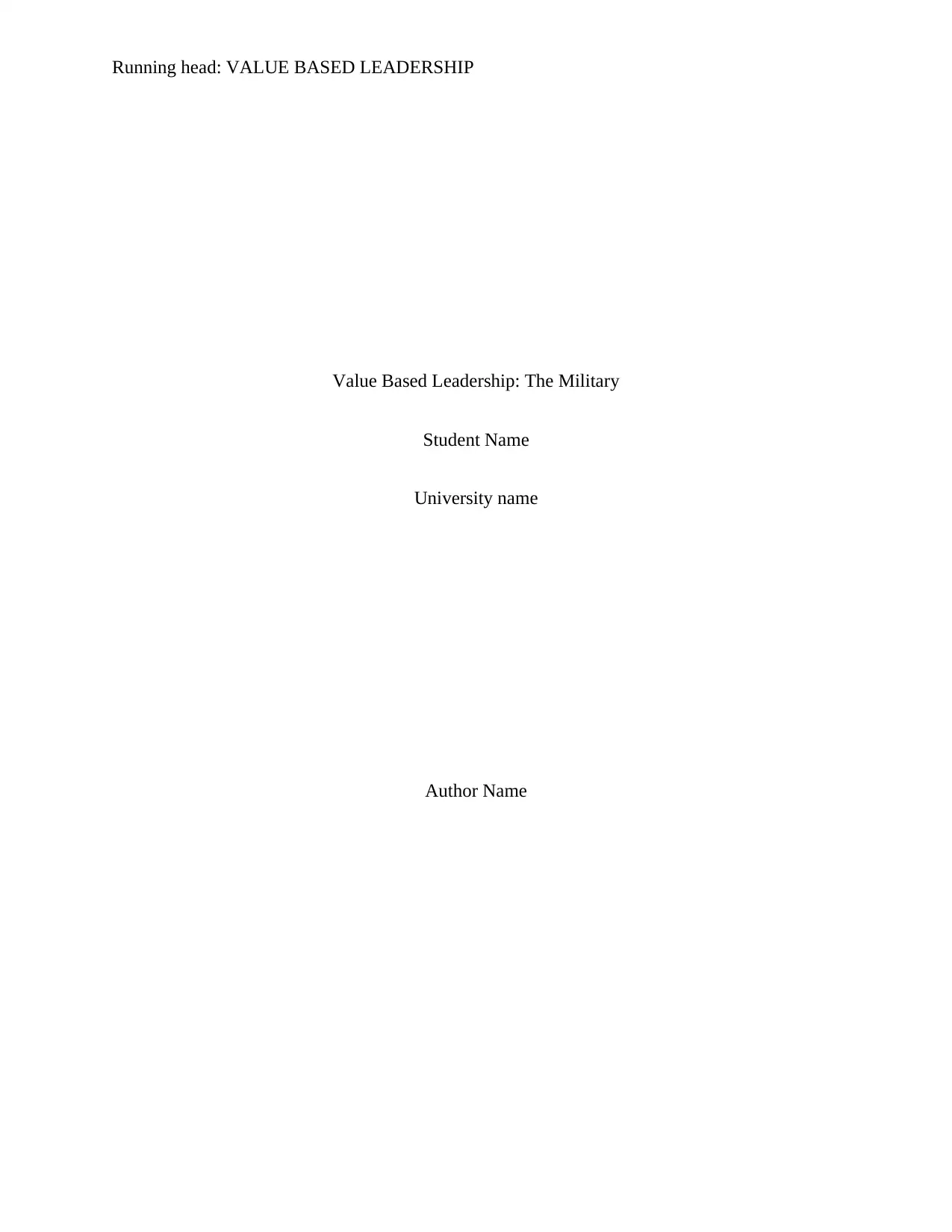
Running head: VALUE BASED LEADERSHIP
Value Based Leadership: The Military
Student Name
University name
Author Name
Value Based Leadership: The Military
Student Name
University name
Author Name
Paraphrase This Document
Need a fresh take? Get an instant paraphrase of this document with our AI Paraphraser
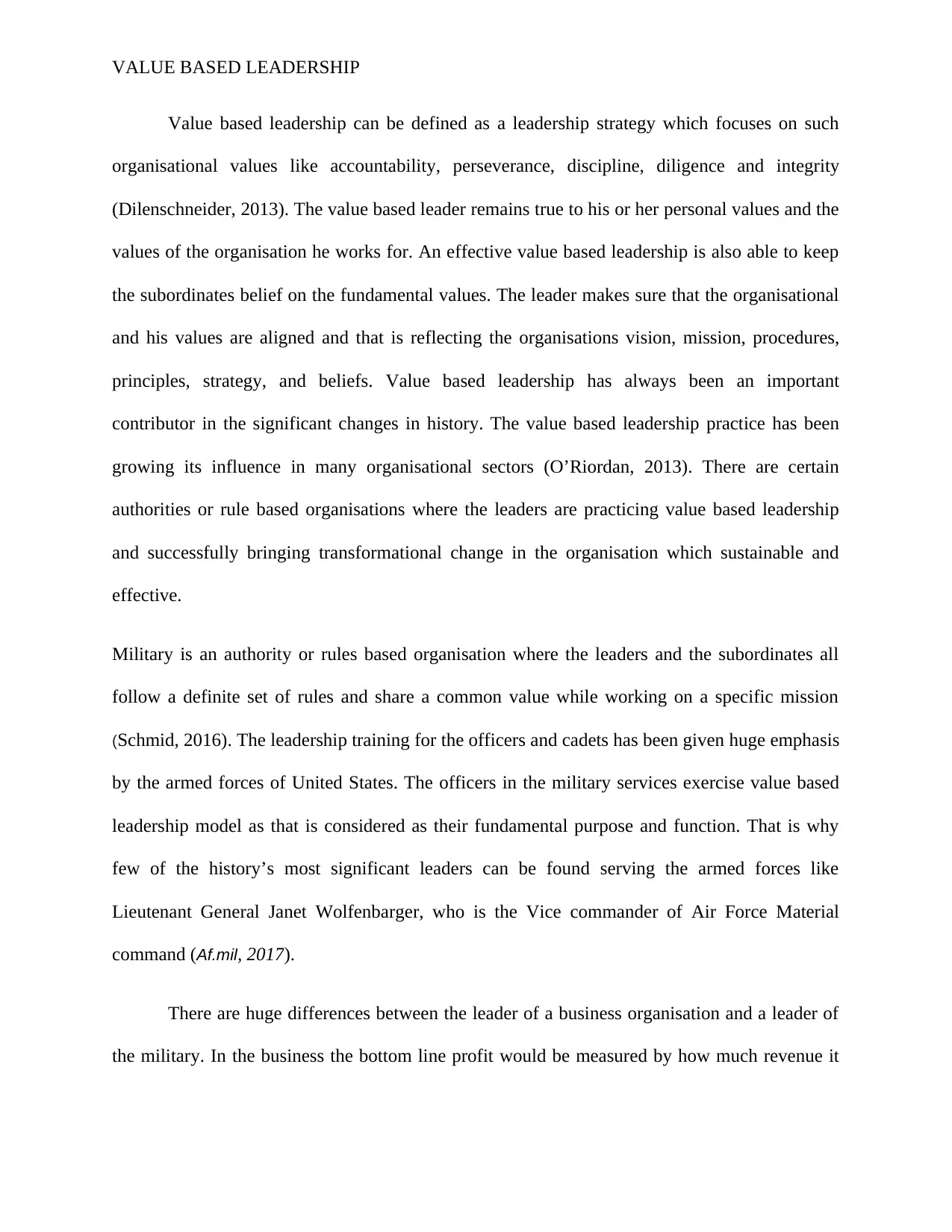
VALUE BASED LEADERSHIP
Value based leadership can be defined as a leadership strategy which focuses on such
organisational values like accountability, perseverance, discipline, diligence and integrity
(Dilenschneider, 2013). The value based leader remains true to his or her personal values and the
values of the organisation he works for. An effective value based leadership is also able to keep
the subordinates belief on the fundamental values. The leader makes sure that the organisational
and his values are aligned and that is reflecting the organisations vision, mission, procedures,
principles, strategy, and beliefs. Value based leadership has always been an important
contributor in the significant changes in history. The value based leadership practice has been
growing its influence in many organisational sectors (O’Riordan, 2013). There are certain
authorities or rule based organisations where the leaders are practicing value based leadership
and successfully bringing transformational change in the organisation which sustainable and
effective.
Military is an authority or rules based organisation where the leaders and the subordinates all
follow a definite set of rules and share a common value while working on a specific mission
(Schmid, 2016). The leadership training for the officers and cadets has been given huge emphasis
by the armed forces of United States. The officers in the military services exercise value based
leadership model as that is considered as their fundamental purpose and function. That is why
few of the history’s most significant leaders can be found serving the armed forces like
Lieutenant General Janet Wolfenbarger, who is the Vice commander of Air Force Material
command (Af.mil, 2017).
There are huge differences between the leader of a business organisation and a leader of
the military. In the business the bottom line profit would be measured by how much revenue it
Value based leadership can be defined as a leadership strategy which focuses on such
organisational values like accountability, perseverance, discipline, diligence and integrity
(Dilenschneider, 2013). The value based leader remains true to his or her personal values and the
values of the organisation he works for. An effective value based leadership is also able to keep
the subordinates belief on the fundamental values. The leader makes sure that the organisational
and his values are aligned and that is reflecting the organisations vision, mission, procedures,
principles, strategy, and beliefs. Value based leadership has always been an important
contributor in the significant changes in history. The value based leadership practice has been
growing its influence in many organisational sectors (O’Riordan, 2013). There are certain
authorities or rule based organisations where the leaders are practicing value based leadership
and successfully bringing transformational change in the organisation which sustainable and
effective.
Military is an authority or rules based organisation where the leaders and the subordinates all
follow a definite set of rules and share a common value while working on a specific mission
(Schmid, 2016). The leadership training for the officers and cadets has been given huge emphasis
by the armed forces of United States. The officers in the military services exercise value based
leadership model as that is considered as their fundamental purpose and function. That is why
few of the history’s most significant leaders can be found serving the armed forces like
Lieutenant General Janet Wolfenbarger, who is the Vice commander of Air Force Material
command (Af.mil, 2017).
There are huge differences between the leader of a business organisation and a leader of
the military. In the business the bottom line profit would be measured by how much revenue it
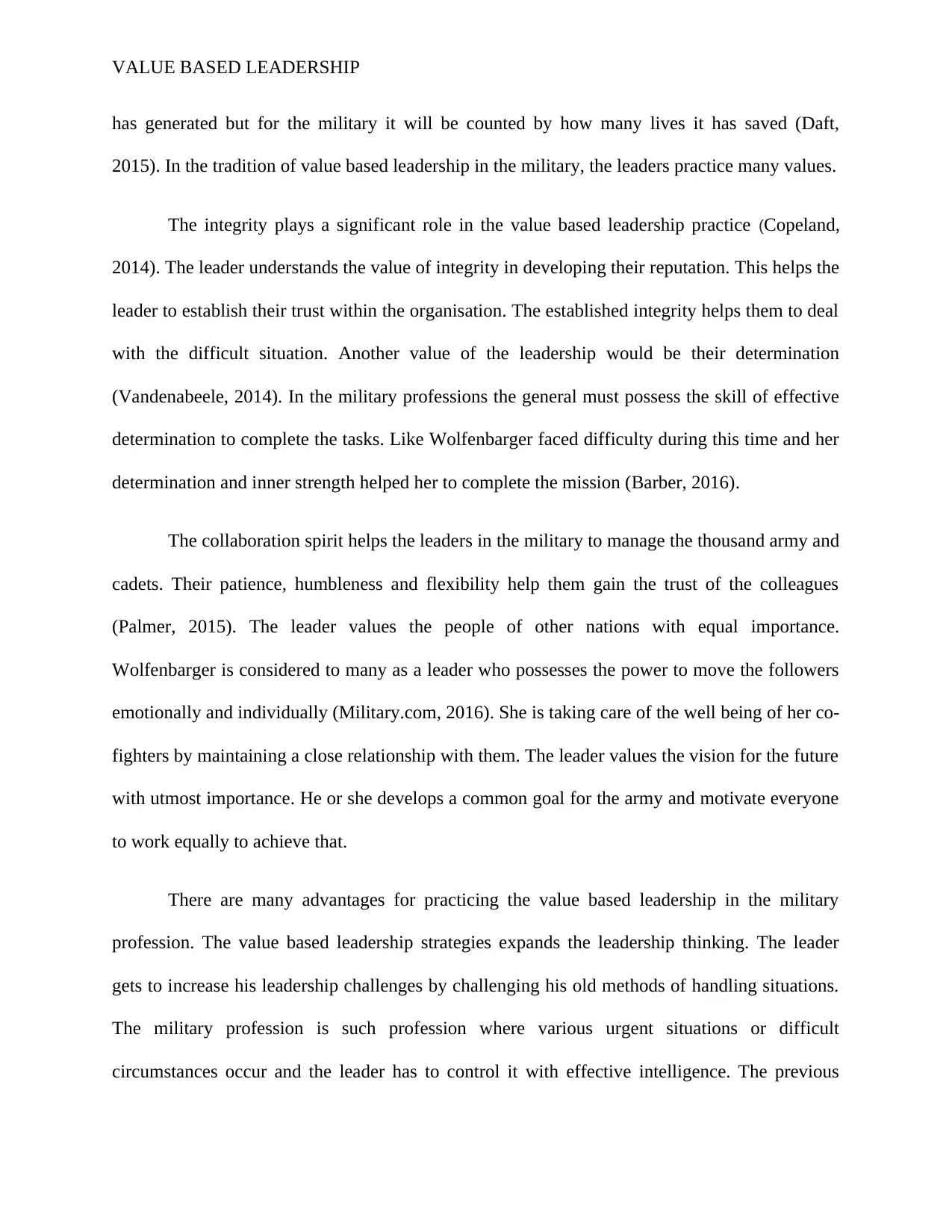
VALUE BASED LEADERSHIP
has generated but for the military it will be counted by how many lives it has saved (Daft,
2015). In the tradition of value based leadership in the military, the leaders practice many values.
The integrity plays a significant role in the value based leadership practice (Copeland,
2014). The leader understands the value of integrity in developing their reputation. This helps the
leader to establish their trust within the organisation. The established integrity helps them to deal
with the difficult situation. Another value of the leadership would be their determination
(Vandenabeele, 2014). In the military professions the general must possess the skill of effective
determination to complete the tasks. Like Wolfenbarger faced difficulty during this time and her
determination and inner strength helped her to complete the mission (Barber, 2016).
The collaboration spirit helps the leaders in the military to manage the thousand army and
cadets. Their patience, humbleness and flexibility help them gain the trust of the colleagues
(Palmer, 2015). The leader values the people of other nations with equal importance.
Wolfenbarger is considered to many as a leader who possesses the power to move the followers
emotionally and individually (Military.com, 2016). She is taking care of the well being of her co-
fighters by maintaining a close relationship with them. The leader values the vision for the future
with utmost importance. He or she develops a common goal for the army and motivate everyone
to work equally to achieve that.
There are many advantages for practicing the value based leadership in the military
profession. The value based leadership strategies expands the leadership thinking. The leader
gets to increase his leadership challenges by challenging his old methods of handling situations.
The military profession is such profession where various urgent situations or difficult
circumstances occur and the leader has to control it with effective intelligence. The previous
has generated but for the military it will be counted by how many lives it has saved (Daft,
2015). In the tradition of value based leadership in the military, the leaders practice many values.
The integrity plays a significant role in the value based leadership practice (Copeland,
2014). The leader understands the value of integrity in developing their reputation. This helps the
leader to establish their trust within the organisation. The established integrity helps them to deal
with the difficult situation. Another value of the leadership would be their determination
(Vandenabeele, 2014). In the military professions the general must possess the skill of effective
determination to complete the tasks. Like Wolfenbarger faced difficulty during this time and her
determination and inner strength helped her to complete the mission (Barber, 2016).
The collaboration spirit helps the leaders in the military to manage the thousand army and
cadets. Their patience, humbleness and flexibility help them gain the trust of the colleagues
(Palmer, 2015). The leader values the people of other nations with equal importance.
Wolfenbarger is considered to many as a leader who possesses the power to move the followers
emotionally and individually (Military.com, 2016). She is taking care of the well being of her co-
fighters by maintaining a close relationship with them. The leader values the vision for the future
with utmost importance. He or she develops a common goal for the army and motivate everyone
to work equally to achieve that.
There are many advantages for practicing the value based leadership in the military
profession. The value based leadership strategies expands the leadership thinking. The leader
gets to increase his leadership challenges by challenging his old methods of handling situations.
The military profession is such profession where various urgent situations or difficult
circumstances occur and the leader has to control it with effective intelligence. The previous
⊘ This is a preview!⊘
Do you want full access?
Subscribe today to unlock all pages.

Trusted by 1+ million students worldwide

VALUE BASED LEADERSHIP
methods have been applied by other leaders for previous situations but as the world has been
experiencing great changes through globalization or digitization, the challenges are also
transforming to something more challenging. The value based leadership helps the leader to
encourage applying ne methods without ignoring the old values.
Managing thousands of cadets appears to be really difficult at times for the leaders in the
military. Value based leadership teaches the leader to value of effective communication with the
subordinates and colleagues. As the leader values each individual his communication skills get
improved. The advantage of communicating well with the subordinates help the value based
leadership solves the minor problems easily and eventually the relationships get improved.
The value based leadership helps the leaders to embrace the personal value as well as the
organisational value. The fulfilling of values will not only help the leaders feel satisfied they will
be able to help others fell the same way. The military profession often becomes very stressful for
young minds, physically, psychologically both. The leaders have to take responsibility in order to
resolve those and help the young army professionals to overcome such stress. The army should
be taught and reminded the values of USA military. Their loyalty, respect and selfless service
towards country will help them to follow the proper route (Army.mil, 2017). These values shared
by the leader as well as his subordinates. The value based leadership really helps in such
situation where the army needs guidance so that stay focused in their desired mission. To guide
them and help them to overcome the stress the leaders’ value based leadership becomes really
helpful.
The military as an organisation suffers from many issues and complicated situations. If
any important values are compromised the value based leadership helps the leaders to resist the
methods have been applied by other leaders for previous situations but as the world has been
experiencing great changes through globalization or digitization, the challenges are also
transforming to something more challenging. The value based leadership helps the leader to
encourage applying ne methods without ignoring the old values.
Managing thousands of cadets appears to be really difficult at times for the leaders in the
military. Value based leadership teaches the leader to value of effective communication with the
subordinates and colleagues. As the leader values each individual his communication skills get
improved. The advantage of communicating well with the subordinates help the value based
leadership solves the minor problems easily and eventually the relationships get improved.
The value based leadership helps the leaders to embrace the personal value as well as the
organisational value. The fulfilling of values will not only help the leaders feel satisfied they will
be able to help others fell the same way. The military profession often becomes very stressful for
young minds, physically, psychologically both. The leaders have to take responsibility in order to
resolve those and help the young army professionals to overcome such stress. The army should
be taught and reminded the values of USA military. Their loyalty, respect and selfless service
towards country will help them to follow the proper route (Army.mil, 2017). These values shared
by the leader as well as his subordinates. The value based leadership really helps in such
situation where the army needs guidance so that stay focused in their desired mission. To guide
them and help them to overcome the stress the leaders’ value based leadership becomes really
helpful.
The military as an organisation suffers from many issues and complicated situations. If
any important values are compromised the value based leadership helps the leaders to resist the
Paraphrase This Document
Need a fresh take? Get an instant paraphrase of this document with our AI Paraphraser
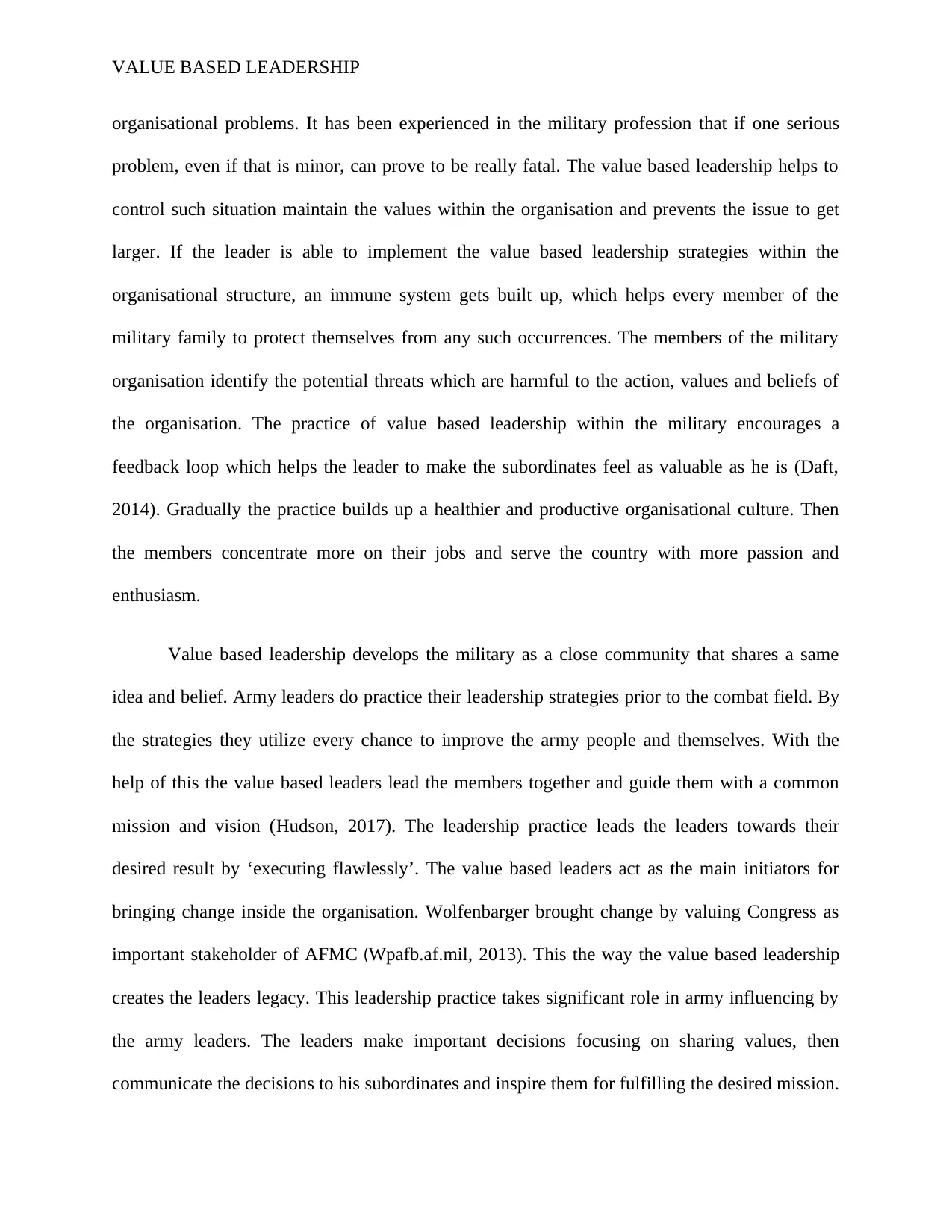
VALUE BASED LEADERSHIP
organisational problems. It has been experienced in the military profession that if one serious
problem, even if that is minor, can prove to be really fatal. The value based leadership helps to
control such situation maintain the values within the organisation and prevents the issue to get
larger. If the leader is able to implement the value based leadership strategies within the
organisational structure, an immune system gets built up, which helps every member of the
military family to protect themselves from any such occurrences. The members of the military
organisation identify the potential threats which are harmful to the action, values and beliefs of
the organisation. The practice of value based leadership within the military encourages a
feedback loop which helps the leader to make the subordinates feel as valuable as he is (Daft,
2014). Gradually the practice builds up a healthier and productive organisational culture. Then
the members concentrate more on their jobs and serve the country with more passion and
enthusiasm.
Value based leadership develops the military as a close community that shares a same
idea and belief. Army leaders do practice their leadership strategies prior to the combat field. By
the strategies they utilize every chance to improve the army people and themselves. With the
help of this the value based leaders lead the members together and guide them with a common
mission and vision (Hudson, 2017). The leadership practice leads the leaders towards their
desired result by ‘executing flawlessly’. The value based leaders act as the main initiators for
bringing change inside the organisation. Wolfenbarger brought change by valuing Congress as
important stakeholder of AFMC (Wpafb.af.mil, 2013). This the way the value based leadership
creates the leaders legacy. This leadership practice takes significant role in army influencing by
the army leaders. The leaders make important decisions focusing on sharing values, then
communicate the decisions to his subordinates and inspire them for fulfilling the desired mission.
organisational problems. It has been experienced in the military profession that if one serious
problem, even if that is minor, can prove to be really fatal. The value based leadership helps to
control such situation maintain the values within the organisation and prevents the issue to get
larger. If the leader is able to implement the value based leadership strategies within the
organisational structure, an immune system gets built up, which helps every member of the
military family to protect themselves from any such occurrences. The members of the military
organisation identify the potential threats which are harmful to the action, values and beliefs of
the organisation. The practice of value based leadership within the military encourages a
feedback loop which helps the leader to make the subordinates feel as valuable as he is (Daft,
2014). Gradually the practice builds up a healthier and productive organisational culture. Then
the members concentrate more on their jobs and serve the country with more passion and
enthusiasm.
Value based leadership develops the military as a close community that shares a same
idea and belief. Army leaders do practice their leadership strategies prior to the combat field. By
the strategies they utilize every chance to improve the army people and themselves. With the
help of this the value based leaders lead the members together and guide them with a common
mission and vision (Hudson, 2017). The leadership practice leads the leaders towards their
desired result by ‘executing flawlessly’. The value based leaders act as the main initiators for
bringing change inside the organisation. Wolfenbarger brought change by valuing Congress as
important stakeholder of AFMC (Wpafb.af.mil, 2013). This the way the value based leadership
creates the leaders legacy. This leadership practice takes significant role in army influencing by
the army leaders. The leaders make important decisions focusing on sharing values, then
communicate the decisions to his subordinates and inspire them for fulfilling the desired mission.
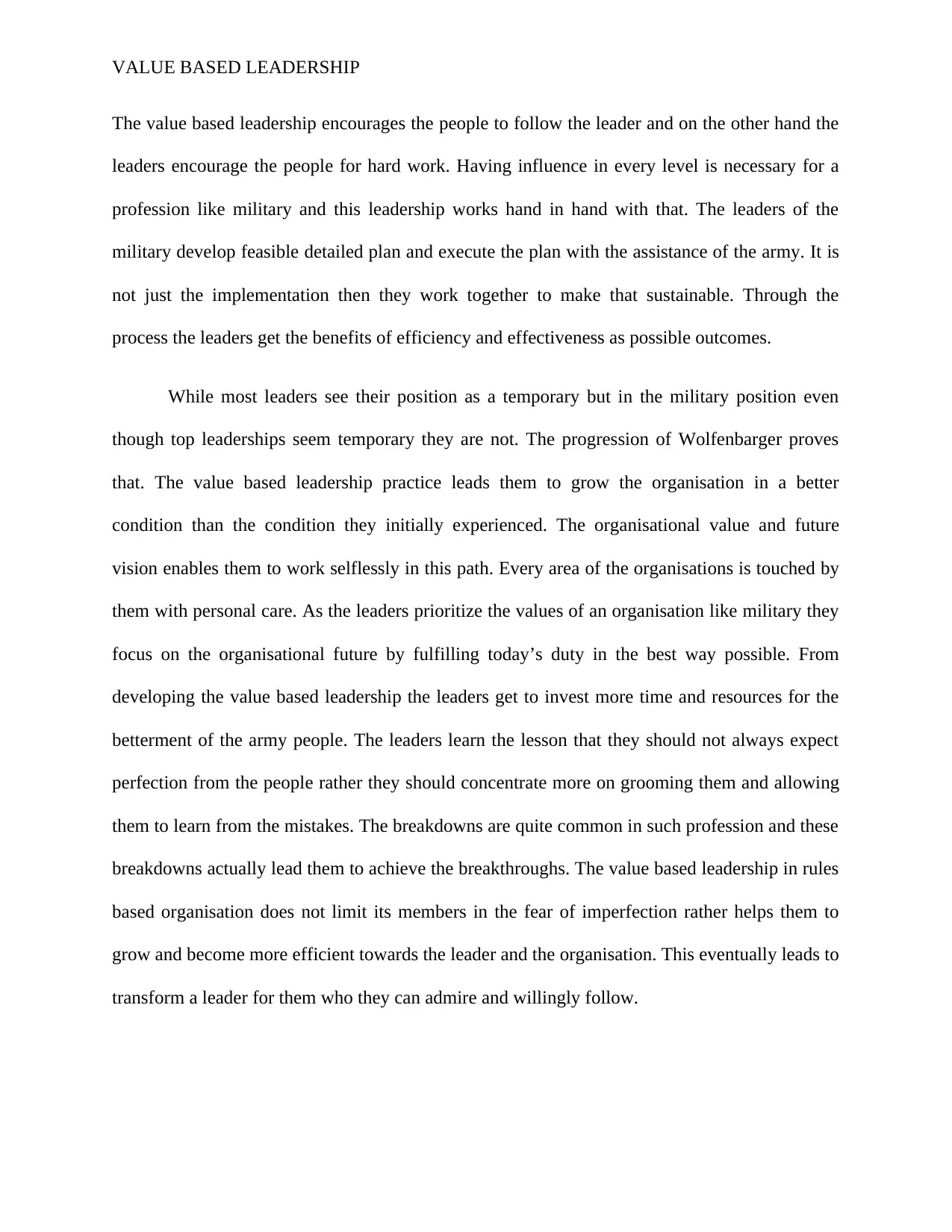
VALUE BASED LEADERSHIP
The value based leadership encourages the people to follow the leader and on the other hand the
leaders encourage the people for hard work. Having influence in every level is necessary for a
profession like military and this leadership works hand in hand with that. The leaders of the
military develop feasible detailed plan and execute the plan with the assistance of the army. It is
not just the implementation then they work together to make that sustainable. Through the
process the leaders get the benefits of efficiency and effectiveness as possible outcomes.
While most leaders see their position as a temporary but in the military position even
though top leaderships seem temporary they are not. The progression of Wolfenbarger proves
that. The value based leadership practice leads them to grow the organisation in a better
condition than the condition they initially experienced. The organisational value and future
vision enables them to work selflessly in this path. Every area of the organisations is touched by
them with personal care. As the leaders prioritize the values of an organisation like military they
focus on the organisational future by fulfilling today’s duty in the best way possible. From
developing the value based leadership the leaders get to invest more time and resources for the
betterment of the army people. The leaders learn the lesson that they should not always expect
perfection from the people rather they should concentrate more on grooming them and allowing
them to learn from the mistakes. The breakdowns are quite common in such profession and these
breakdowns actually lead them to achieve the breakthroughs. The value based leadership in rules
based organisation does not limit its members in the fear of imperfection rather helps them to
grow and become more efficient towards the leader and the organisation. This eventually leads to
transform a leader for them who they can admire and willingly follow.
The value based leadership encourages the people to follow the leader and on the other hand the
leaders encourage the people for hard work. Having influence in every level is necessary for a
profession like military and this leadership works hand in hand with that. The leaders of the
military develop feasible detailed plan and execute the plan with the assistance of the army. It is
not just the implementation then they work together to make that sustainable. Through the
process the leaders get the benefits of efficiency and effectiveness as possible outcomes.
While most leaders see their position as a temporary but in the military position even
though top leaderships seem temporary they are not. The progression of Wolfenbarger proves
that. The value based leadership practice leads them to grow the organisation in a better
condition than the condition they initially experienced. The organisational value and future
vision enables them to work selflessly in this path. Every area of the organisations is touched by
them with personal care. As the leaders prioritize the values of an organisation like military they
focus on the organisational future by fulfilling today’s duty in the best way possible. From
developing the value based leadership the leaders get to invest more time and resources for the
betterment of the army people. The leaders learn the lesson that they should not always expect
perfection from the people rather they should concentrate more on grooming them and allowing
them to learn from the mistakes. The breakdowns are quite common in such profession and these
breakdowns actually lead them to achieve the breakthroughs. The value based leadership in rules
based organisation does not limit its members in the fear of imperfection rather helps them to
grow and become more efficient towards the leader and the organisation. This eventually leads to
transform a leader for them who they can admire and willingly follow.
⊘ This is a preview!⊘
Do you want full access?
Subscribe today to unlock all pages.

Trusted by 1+ million students worldwide
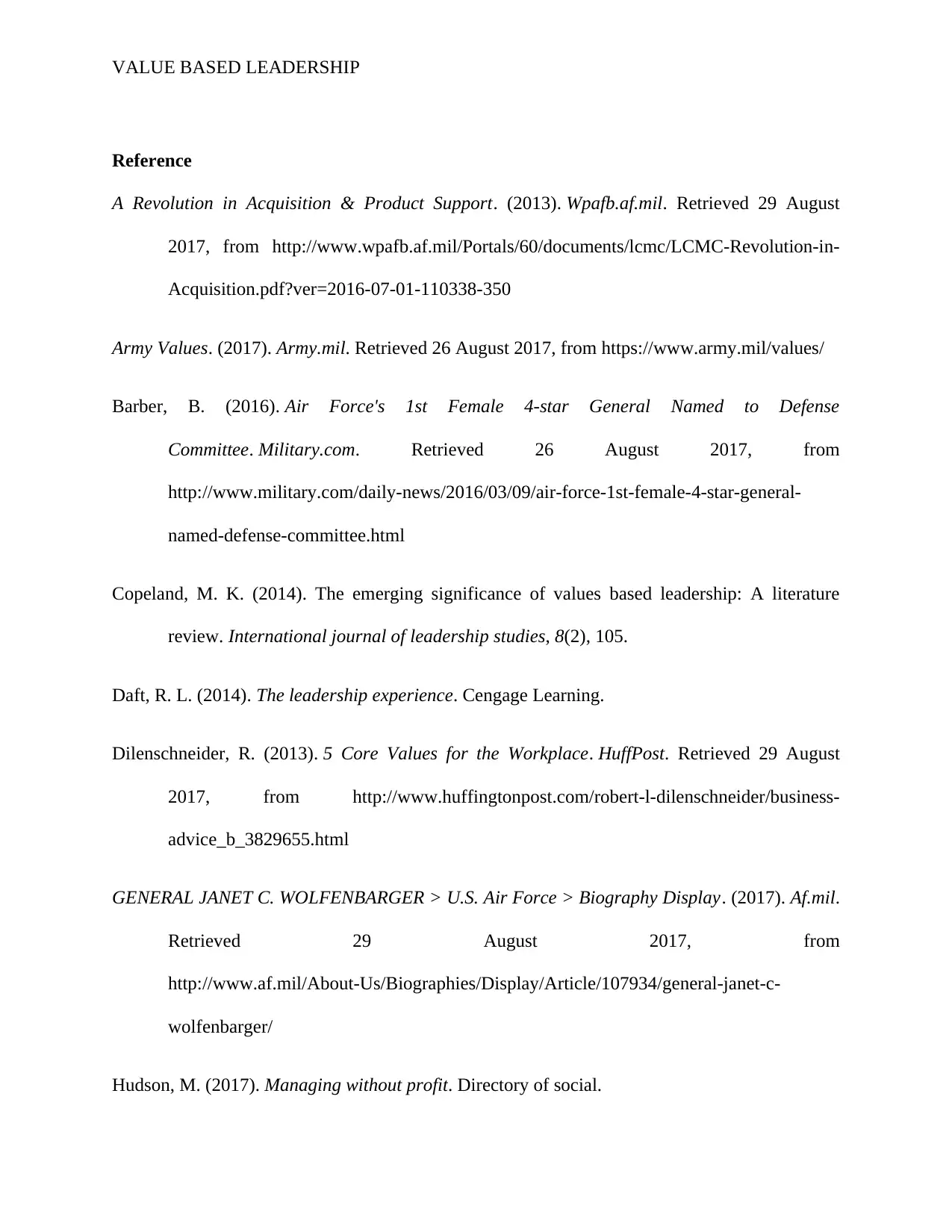
VALUE BASED LEADERSHIP
Reference
A Revolution in Acquisition & Product Support. (2013). Wpafb.af.mil. Retrieved 29 August
2017, from http://www.wpafb.af.mil/Portals/60/documents/lcmc/LCMC-Revolution-in-
Acquisition.pdf?ver=2016-07-01-110338-350
Army Values. (2017). Army.mil. Retrieved 26 August 2017, from https://www.army.mil/values/
Barber, B. (2016). Air Force's 1st Female 4-star General Named to Defense
Committee. Military.com. Retrieved 26 August 2017, from
http://www.military.com/daily-news/2016/03/09/air-force-1st-female-4-star-general-
named-defense-committee.html
Copeland, M. K. (2014). The emerging significance of values based leadership: A literature
review. International journal of leadership studies, 8(2), 105.
Daft, R. L. (2014). The leadership experience. Cengage Learning.
Dilenschneider, R. (2013). 5 Core Values for the Workplace. HuffPost. Retrieved 29 August
2017, from http://www.huffingtonpost.com/robert-l-dilenschneider/business-
advice_b_3829655.html
GENERAL JANET C. WOLFENBARGER > U.S. Air Force > Biography Display. (2017). Af.mil.
Retrieved 29 August 2017, from
http://www.af.mil/About-Us/Biographies/Display/Article/107934/general-janet-c-
wolfenbarger/
Hudson, M. (2017). Managing without profit. Directory of social.
Reference
A Revolution in Acquisition & Product Support. (2013). Wpafb.af.mil. Retrieved 29 August
2017, from http://www.wpafb.af.mil/Portals/60/documents/lcmc/LCMC-Revolution-in-
Acquisition.pdf?ver=2016-07-01-110338-350
Army Values. (2017). Army.mil. Retrieved 26 August 2017, from https://www.army.mil/values/
Barber, B. (2016). Air Force's 1st Female 4-star General Named to Defense
Committee. Military.com. Retrieved 26 August 2017, from
http://www.military.com/daily-news/2016/03/09/air-force-1st-female-4-star-general-
named-defense-committee.html
Copeland, M. K. (2014). The emerging significance of values based leadership: A literature
review. International journal of leadership studies, 8(2), 105.
Daft, R. L. (2014). The leadership experience. Cengage Learning.
Dilenschneider, R. (2013). 5 Core Values for the Workplace. HuffPost. Retrieved 29 August
2017, from http://www.huffingtonpost.com/robert-l-dilenschneider/business-
advice_b_3829655.html
GENERAL JANET C. WOLFENBARGER > U.S. Air Force > Biography Display. (2017). Af.mil.
Retrieved 29 August 2017, from
http://www.af.mil/About-Us/Biographies/Display/Article/107934/general-janet-c-
wolfenbarger/
Hudson, M. (2017). Managing without profit. Directory of social.
Paraphrase This Document
Need a fresh take? Get an instant paraphrase of this document with our AI Paraphraser
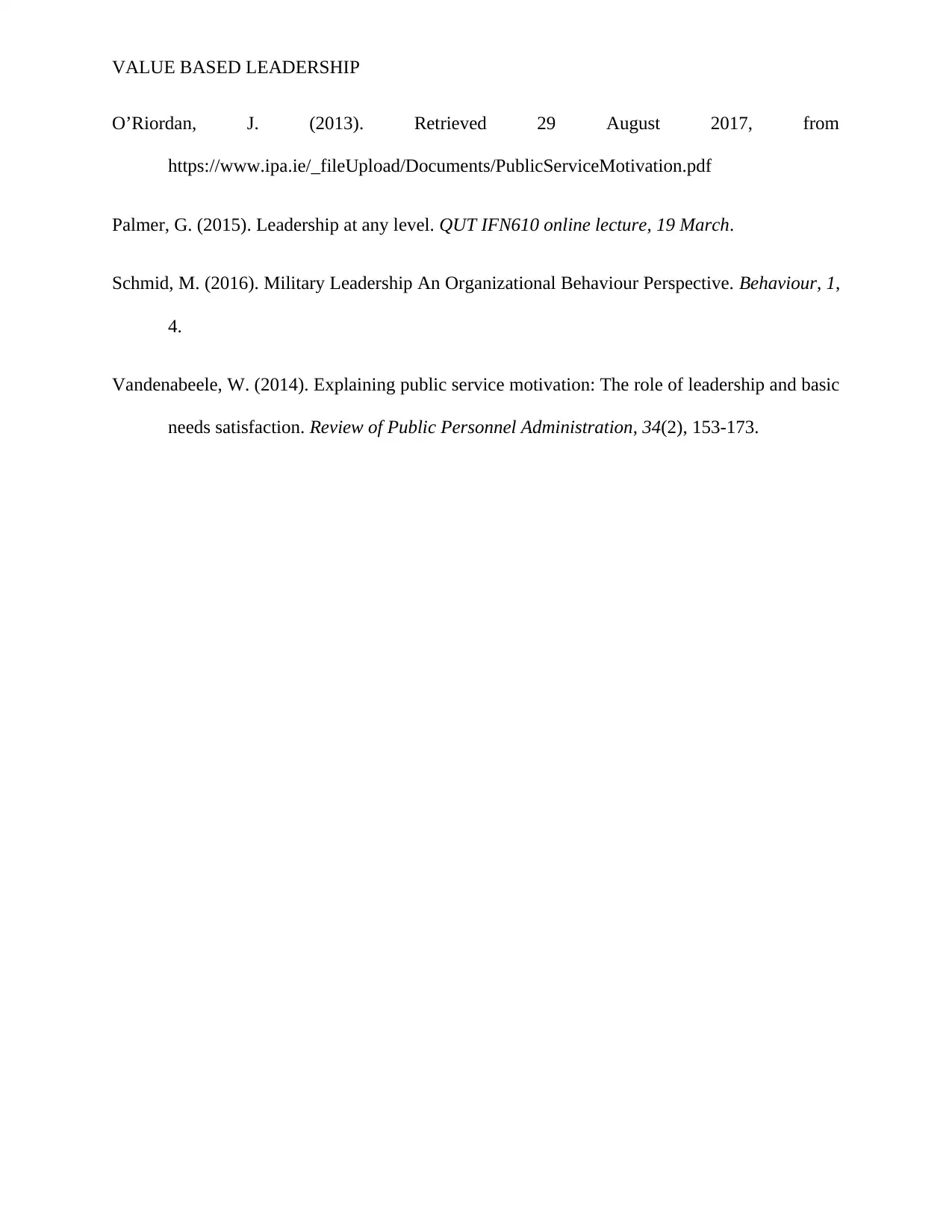
VALUE BASED LEADERSHIP
O’Riordan, J. (2013). Retrieved 29 August 2017, from
https://www.ipa.ie/_fileUpload/Documents/PublicServiceMotivation.pdf
Palmer, G. (2015). Leadership at any level. QUT IFN610 online lecture, 19 March.
Schmid, M. (2016). Military Leadership An Organizational Behaviour Perspective. Behaviour, 1,
4.
Vandenabeele, W. (2014). Explaining public service motivation: The role of leadership and basic
needs satisfaction. Review of Public Personnel Administration, 34(2), 153-173.
O’Riordan, J. (2013). Retrieved 29 August 2017, from
https://www.ipa.ie/_fileUpload/Documents/PublicServiceMotivation.pdf
Palmer, G. (2015). Leadership at any level. QUT IFN610 online lecture, 19 March.
Schmid, M. (2016). Military Leadership An Organizational Behaviour Perspective. Behaviour, 1,
4.
Vandenabeele, W. (2014). Explaining public service motivation: The role of leadership and basic
needs satisfaction. Review of Public Personnel Administration, 34(2), 153-173.
1 out of 8
Related Documents
Your All-in-One AI-Powered Toolkit for Academic Success.
+13062052269
info@desklib.com
Available 24*7 on WhatsApp / Email
![[object Object]](/_next/static/media/star-bottom.7253800d.svg)
Unlock your academic potential
Copyright © 2020–2025 A2Z Services. All Rights Reserved. Developed and managed by ZUCOL.




